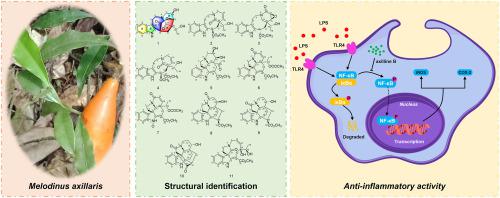Journal of Ethnopharmacology ( IF 4.8 ) Pub Date : 2024-01-17 , DOI: 10.1016/j.jep.2024.117771
Kaicheng Du 1 , Yanan Liang 1 , Zihao Song 1 , Changwei Zheng 1 , Lantao Lai 1 , Kunqi Zong 1 , Yumeng Wang 1 , Dali Meng 1

|
Ethnopharmacological relevance
Melodinus axillaris W.T.Wang has been widely used as an important medicine in China. In the folk of China, its whole plant has been used for fractures, rheumatic heart disease, testitis, hernia, abdominal pain, and dyspepsia, etc. Despite its extensive use, there is a shortage of literature investigating the specific bioactive compounds and underlying mechanisms responsible for their anti-inflammatory effects. This knowledge gap serves as the primary impetus for conducting this study, which aims to shed light on the previously unexplored therapeutic potential of M. axillaris.
Aim of the study
This study aims to investigate the material basis and potential mechanism of anti-inflammatory activity of M. axillaris.
Materials and methods
Compounds were isolated from the 95% ethanol extract of M. axillaris using a systematic phytochemical method. The structures were established by extensive spectroscopic analysis, including 1D and 2D NMR, HR-ESI-MS, ECD calculation, and DP4+ analysis. The anti-inflammatory activities of ethanol extract and compounds from M. axillaris were tested by an inflammation model of LPS-stimulated RAW264.7 cells in vitro. Western blot analysis was employed to evaluate the expressions of COX-2, iNOS, and NF-κB signaling pathways, aiming to elucidate the underlying mechanisms.
Results
Eleven undescribed monoterpenoid indole alkaloids (MIAs), axillines A−K (1–11), along with thirteen known analogs were isolated from M. axillaris. Compound 1 was the first representative of vincadine alkaloid with unprecedented 6/5/9/6/6 skeletons. Compounds 1–11 and ethanol extract showed significant anti-inflammatory effects in vitro. Among them, compound 2 had the best activity of inhibiting NO release (IC50 = 3.7 ± 0.9 μM). Additionally, subsequent Western blot analysis revealed that 2 could significantly inhibit the up-regulation of NF-κB signaling pathways, iNOS, and COX-2 in LPS-stimulated RAW264.7 cells, thereby demonstrating its anti-inflammatory activity.
Conclusion
This study provides support for the traditional use of M. axillaris in terms of its anti-inflammatory properties and highlights the potential of MIAs as promising candidates for further development as anti-inflammatory drugs.

































 京公网安备 11010802027423号
京公网安备 11010802027423号